English stage and film actor, director, and producer Leslie Howard (1893-1943) is best known for his role as Ashley Wilkes in Gone with the Wind (1939). Other popular films were The Scarlet Pimpernel (1934), The Petrified Forest (1936), Pygmalion (1938), and Intermezzo (1939). During the Second World War, he was active in anti-Nazi propaganda. In 1943 his airliner was shot down, and this sparked modern conspiracy theories regarding his death.
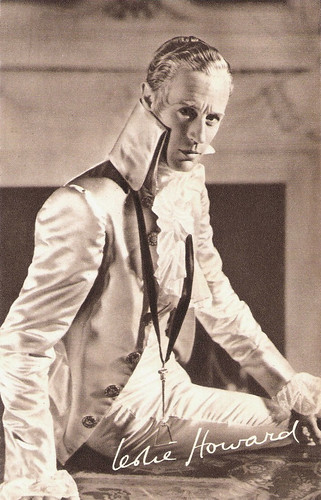
British postcard by Real Photogravure, London, no. 64. Photo: Warner Brothers / First National. Publicity still for The Scarlet Pimpernel (1934).
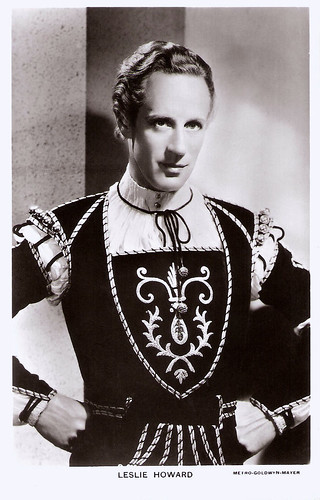
British postcard in the Picturegoer Series by Real Photograph, London, no. 1101. Photo: Metro-Goldwyn-Mayer. Publicity photo for Romeo and Juliet (1936).
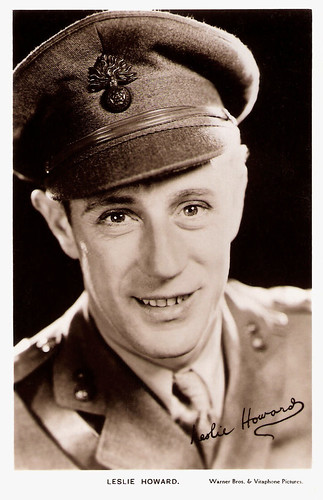
British postcard in the Film Kurier Series, London, no. 64. Photo: Warner Brothers & Vitaphone Pictures.
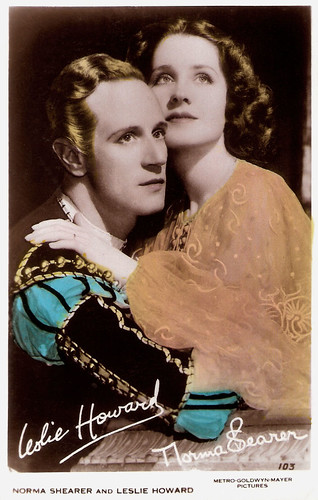
British postcard by Real Photograph, no. 103. Photo: Metro-Goldwyn-Mayer Pictures. Publicity photo for Romeo and Juliet (1936) with Norma Shearer.
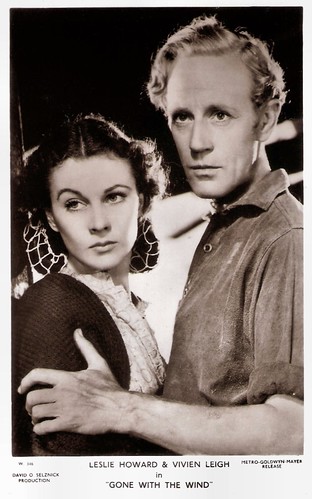
British postcard in the Picturegoer Series, London, no. W. 346. Photo: David O'Selznick Production / Metro-Goldwyn-Mayer. Publicity still for Gone with the Wind (1939) with Vivien Leigh.
Leslie Howard Steiner was born to a British mother, Lilian (née Blumberg) and a Hungarian father, Ferdinand Steiner, in London, UK in 1893. His father was Jewish, and his mother was the granddaughter of a Jewish immigrant from East Prussia who had married into the English upper classes. Arthur, Howard's younger brother, was also an actor, primarily in British comedies. Leslie initially grew up in Vienna, returning to London when his father joined a City stockbroking firm. He was educated at Alleyn's School and Dulwich College, London. He wrote his first play and was producing musical comedies with family and friends by the age of 14. In support of her artistically inclined children and their chums, Howard's mother started the Upper Norwood Dramatic Club to showcase their talents.
Like many others around the time of the First World War, the family changed their name, using Stainer as less German-sounding. Intending Leslie to follow in his footsteps, his father secured him a job as a bank clerk, but the acting bug had already bitten thanks to his mother's fondness for amateur dramatics, and Leslie would take on her adopted maiden name as his own. Leslie Howard made his first short silent film for Clarendon, The Heroine of Mons (1914) directed by his uncle, director-producer Wilfred Noy. Shortly after that, he naively joined the 20th Hussars (although he had never ridden a horse) and served on the Western Front. The Somme disaster of 1916 triggered shell shock, which led to his relinquishing his commission in May 1916. The doctor advised to take up acting as part of his medical treatment.
That same year he married and began his acting career in earnest, his matinee-idol looks helping him to success. Starting out with small roles in the touring companies of 'Peg O' My Heart', 'Charley's Aunt' and the juvenile lead in the road version of Matheson Lang's 'Under Cover', Howard made his London stage debut in 1918 in a small role in Arthur Pinero's 'The Freaks'.
He also appeared in such British silent films as the sports drama The Happy Wanderer (F. Martin Thornton, 1917) and The Lackey and the Lady (Thomas Bentley, 1919). In 1920 Howard and his friend Adrian Brunel founded the short-lived company Minerva Films in London, which produced on a shoestring budget. Howard was the producer and/or actor, and Brunel was the director.
Their films include the comedies The Bump (Adrian Brunel, 1920) starring C. Aubrey Smith, Five Pound Reward (Adrian Brunel, 1920), and Bookworms (Adrian Brunel, 1920), all written by A. A. Milne. Some of these films survive in the archives of the British Film Institute. However, Minerva Films soon went belly up leaving investors like H.G. Wells without a penny. It took some ten years more and the coming of sound that Howard's screen career really would take off, thanks to Hollywood's need to recruit actors with good stage-trained voices, the better to cope with the primitive early recording equipment.
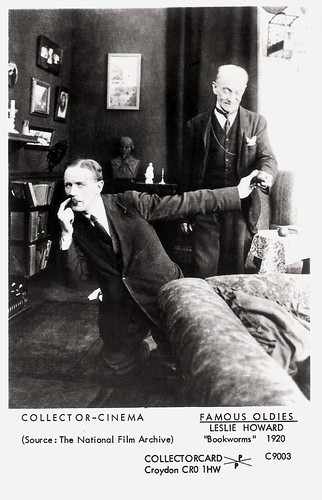
British postcard in the Collector-Cinema Famous Oldies series by Collector card, Croydon, no. C9003. Photo: The National Film Archive. Leslie Howard in Bookworms (Adrian Brunel, 1920).

Italian postcard by Cinema-Illustrazione, no. 23 11. Photo: Metro Goldwyn Mayer. Leslie Howard and Conchita Montenegro in Never the Twain Shall Meet (W.S. Van Dyke, 1931).
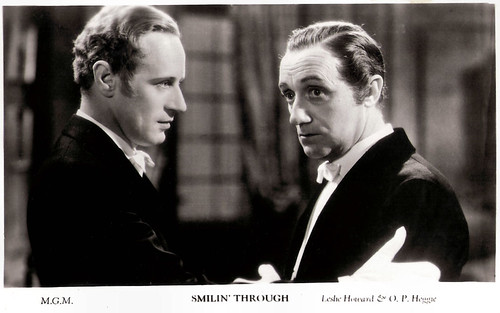
British postcard by Film Weekly in the Film Shots Series. Photo: M.G.M. Publicity still for Smilin' Through (Sidney Franklin, 1932) with O.P. Heggie.
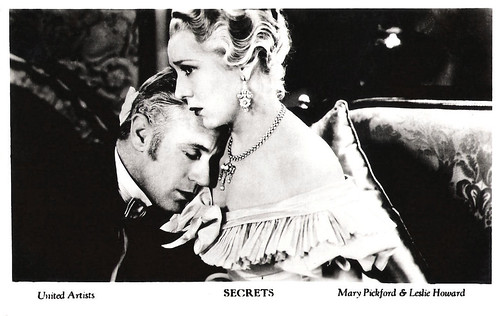
British postcard. Photo: United Artists. Publicity still for Secrets (Frank Borzage, 1933) with Mary Pickford.

British postcard in the Film Shots series by Film Weekly. Photo: Warner. Leslie Howard and Paul Lukas in Captured! (Roy Del Ruth, 1933).
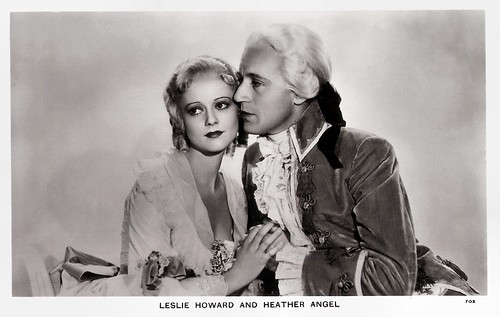
British postcard in the Film Partners Series, London, no. P 123. Photo: Fox. Publicity still for Berkeley Square (Frank Lloyd, 1933) with Heather Angel.
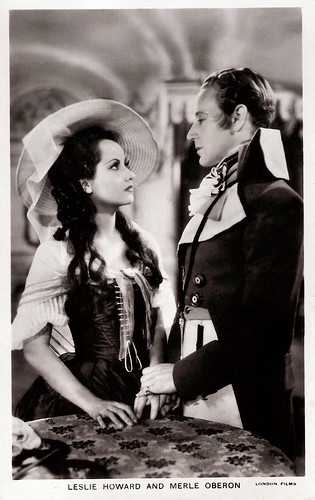
British postcard in the Film Partners Series, London, no. P 150. Photo: London Films. Publicity still for The Scarlet Pimpernel (Harold Young, 1934) with Merle Oberon.
In 1920 after the Minerva debacle, Leslie Howard headed off to the US for his Broadway debut in Just Suppose. Although the comedy-drama was hailed as a success by critics, Howard's performance was not. Undaunted, he appeared in several different types of plays on Broadway such as 'Aren't We All?' (1923), the strange and provocative drama 'Outward Bound' (1924), and his first Broadway smash 'The Green Hat' (1925). He became an undisputed Broadway star with the bedroom farce 'Her Cardboard Lover' (1927). Besides acting, he always seemed to find time to write stories and articles for The New Yorker, Vanity Fair, and Reader's Digest and script plays he hoped to produce one day. His dream came true when he starred in the Broadway productions of his own plays 'Murray Hill' (1927) and 'Out of a Blue Sky' (1930).
After his success as time traveller Peter Standish in 'Berkeley Square' (1929), he launched his Hollywood career. First Howard starred opposite Douglas Fairbanks Jr. in his first sound film, the film version of Outward Bound (Robert Milton, 1930), though in a different role than the one he portrayed on Broadway. Then he repeated the Standish role in the film version of Berkeley Square (Frank Lloyd, 1933), for which he was nominated for an Academy Award for Best Actor. The stage, however, continued to be an important part of his career and Howard frequently juggled acting, producing, and directing duties in the Broadway productions in which he starred. However, he was always best known for his acting, enjoying triumphs in 'The Animal Kingdom' (1932) and 'The Petrified Forest' (1935). He repeated both roles later in films.
But he had the bad timing to open on Broadway in William Shakespeare's 'Hamlet' (1936) just a few weeks after John Gielgud launched a rival production of the same play that was far more successful with both critics and audiences. Howard’s production, his final stage role, lasted only 39 performances. In Hollywood, he became known as the perfect Englishman - slim, tall, intellectual and sensitive. It was a part that he played in many films and a part women would dream about. Howard co-starred with Bette Davis in The Petrified Forest (Archie Mayo, 1936) and reportedly insisted that Humphrey Bogart appeared in the film as gangster Duke Mantee. Howard and Bogart had previously appeared in the play together on Broadway and became lifelong friends. The Bogarts named their daughter Leslie after him.
Howard had earlier co-starred with Bette Davis in the film adaptation of W. Somerset Maugham's book Of Human Bondage (John Cromwell, 1934) and later again in the romantic comedy It's Love I'm After (Archie Mayo, 1937), also co-starring Olivia de Havilland. He played the title character in the British smash hit The Scarlet Pimpernel (Harold Young, 1934) opposite Merle Oberon. In the UK he also appeared as Professor Henry Higgins opposite Wendy Hiller in the film version of George Bernard Shaw's play Pygmalion (Anthony Asquith, Leslie Howard, 1938). It was another hit. Pygmalion earned him another Academy Award nomination for Best Actor, and it was his directorial debut.
In Hollywood, Howard starred with up-and-comer Ingrid Bergman in Intermezzo (Gregory Ratoff, 1939) and with Norma Shearer in a film version of Shakespeare's Romeo and Juliet (George Cukor, 1936). As he became more successful, he also became quite picky about which roles he would do, and usually performed in only two films a year."In 1939, he played against-his-will the character that will always be associated with him, that of Ashley Wilkes, the honour-bound disillusioned intellectual Southern gentleman in Gone with the Wind (Victor Fleming, 1939). TCM: Although it is hard to understand why the passionate, stubborn Scarlett O'Hara (Vivien Leigh) would ever choose Howard's dull, whiny Ashley over Clark Gable's charming, devilish Rhett, Howard did make the ideal symbol of chivalry and Old South gallantry."

British postcard in the Film Partners Series, London, no. PC 203. Photo: MGM. Leslie Howard and Norma Shearer in Romeo and Juliet (George Cukor, 1936).
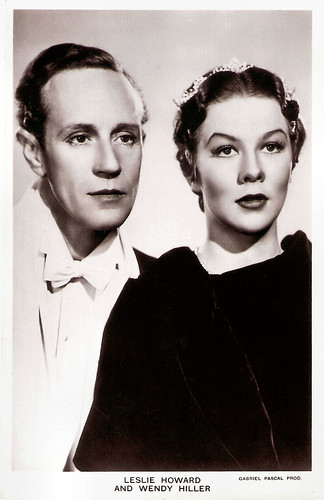
British postcard in the Picturegoer Series, London, no. 1234. Photo: Gabriel Pascal Prod. Publicity still for Pygmalion (Anthony Asquith, Leslie Howard, 1938) with Wendy Hiller.

British postcard in the Colourgraph Series, London, no. C 363. Photo: Selznick International. Leslie Howard in Gone with the Wind (Victor Fleming, 1939).
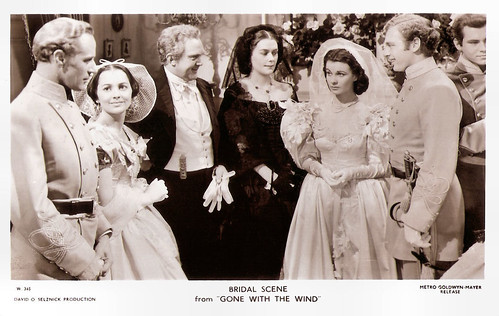
British postcard in the Picturegoer Series, London, no. W. 345. Photo: David O'Selznick Production / Metro-Goldwyn-Mayer. Publicity still for Gone with the Wind (Victor Fleming, 1939) with Olivia de Havilland and Vivien Leigh. Caption: Bridal scene from Gone with the Wind.
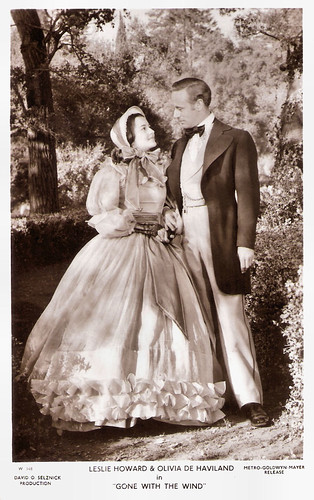
British postcard in the Picturegoer Series, London, no. W. 348. Photo: David O'Selznick Production / Metro-Goldwyn-Mayer. Publicity still for Gone with the Wind (Victor Fleming, 1939) with Olivia de Havilland.

West German postcard by Schneider-Junior, Neunkirchen/Saar, no. 60. Photo: Constantin-Film. Ingrid Bergman and Leslie Howard in Intermezzo (Gregory Ratoff, 1939).
A few days before war broke out Leslie Howard became uncomfortable with Hollywood and returned to England. He could easily have stayed in Hollywood for the duration of the war, but he was one of the first British stars to make a point of returning home. He devoted all his energy on behalf of the war effort. He directed films, wrote articles and made radio broadcasts. Howard starred in such Second World War films as 49th Parallel (Michael Powell, 1941) about a Nazi U-boat crew stranded in Canada with Laurence Olivier, Pimpernel Smith (Leslie Howard, 1941) - a World War II update of the Scarlet Pimpernel story, and The First of the Few/Spitfire (Leslie Howard, 1942) with David Niven, the latter two of which he directed and also co-produced. The First of the Few, a moving wartime biopic of R.J. Mitchell, designer of the Spitfire, was to be his last major screen role.
He stayed behind the camera on The Gentle Sex (Leslie Howard, 1943), contributing only narration, as he felt his onscreen presence would have distracted from the film's main aims, to portray and celebrate the contribution of women to the war effort. In private life, Howard was widely known as a ladies' man. He married Ruth Martin in 1916 and they had two children. His son Ronald Howard (1918) became an actor and is noted for portraying the title character in the television series Sherlock Holmes (1954). However, Leslie Howard is reported to have had an affair with Tallulah Bankhead when they appeared on stage in the UK in 'Her Cardboard Lover' (1927), with Merle Oberon while filming The Scarlet Pimpernel (1934), and with Conchita Montenegro, with whom he appeared in the film Never the Twain Shall Meet (1931). Towards the end of his life, with the full knowledge of his wife, he did take a mistress, Violette Cunningham. The actress who appeared in Pimpernel Smith and First of the Few in minor roles acted as his secretary, but died in 1942 of pneumonia in her early 30s, six months before Howard's death.
Leslie Howard died in 1943 when flying to Bristol, UK, from Lisbon, Portugal. The KLM aircraft, a Douglas DC-3, was shot down by a Luftwaffe maritime fighter aircraft over the Bay of Biscay. Howard was among the 17 fatalities, together with 4 crew members and 12 other passengers. The aircraft had been operating on a scheduled Lisbon–Whitchurch route throughout 1942-1943 that did not pass over what would commonly be referred to as a war zone. By 1942, however, the Germans considered the region an ‘extremely sensitive war zone.’ On 1 June 1943, the aircraft came under attack by eight Nazi maritime fighters, and the DC-3's last radio message indicated it was being fired upon.
According to German documents, the DC-3 was shot down, some 800 km from Bordeaux, France, and 320 km northwest of Coruña, Spain. A long-standing hypothesis states that the Germans believed that UK Prime Minister Winston Churchill, who had been in Algiers, was on board the flight. Two books focusing on the final flight, 'Flight 777' (Ian Colvin, 1957) and 'In Search of My Father: A Portrait of Leslie Howard' (Ronald Howard, 1984), concluded that the Germans shot down Howard's DC-3 for the specific purpose of killing him. Howard had been travelling through Spain and Portugal, ostensibly lecturing on film, but also meeting with local propagandists and shoring up support for the Allied cause. The chance to demoralise Britain with the loss of one of its most outspokenly patriotic figures may have motivated the Luftwaffe attack.
Ronald Howard was convinced the order to shoot down his father’s airliner came directly from Joseph Goebbels, Minister of Propaganda in Nazi Germany, who had been ridiculed in one of Howard's films and who believed Howard to be the most dangerous British propagandist. The 2010 biography by Estel Eforgan, 'Leslie Howard: The Lost Actor', examined currently available evidence and concluded that Howard was not a specific target, corroborating the claims by German sources that the shootdown was ‘an error in judgement’. At the time of his death, Leslie Howard was 50. The shockingly sudden death of this quintessentially English film star was a national tragedy. In 1959, his daughter, Leslie Ruth Howard (1924), also published a memoir of her father, 'A Quite Remarkable Father: A Biography of Leslie Howard'.

British cigarette card in the Second Film Stars series by John Player & Sons, no. 26. Photo: Radio. Collection: Geoffrey Donaldson Institute.

British postcard by Real Photograph, no. 97. Photo: First National Films.
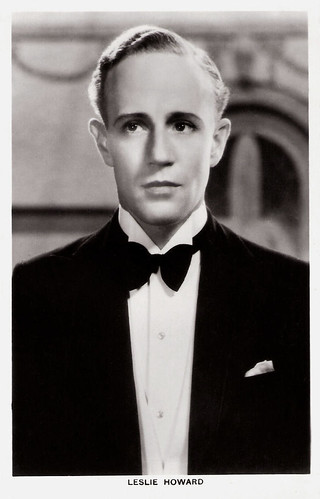
British postcard in the Picturegoer Series by Real Photograph, London, no. 651.
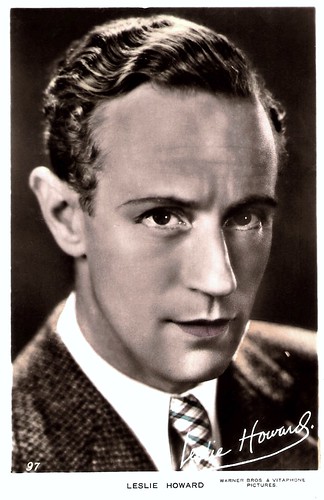
British postcard by Art Photo, no. 97. Photo: Warner Bros & Vitaphone Pictures.
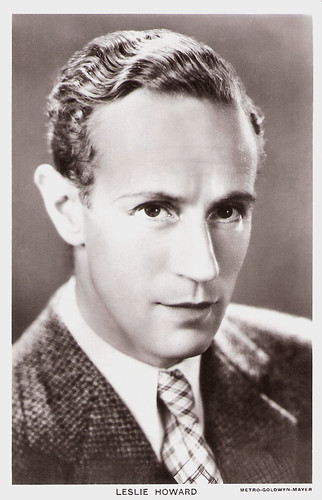
British postcard in the Picturegoer Series, London, no. 651a. Photo: Metro-Goldwyn-Mayer.
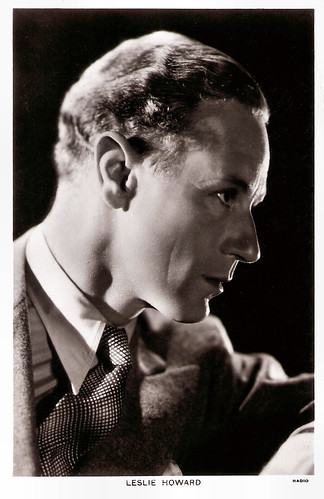
British postcard in the Picturegoer Series, London, no. 884. Photo: Radio.

British postcard in the Picturegoer Series, London, no. 1101a. Photo: Gabriel Pascal Prod.
Sources: Michael Brooke (BFI Screenonline), Hal Erickson (AllMovie - page now defunct), Dan van Neste (Films of the Golden Age), Tony Fontana (IMDb), TCM (page now defunct), Wikipedia, and IMDb.

British postcard by Real Photogravure, London, no. 64. Photo: Warner Brothers / First National. Publicity still for The Scarlet Pimpernel (1934).

British postcard in the Picturegoer Series by Real Photograph, London, no. 1101. Photo: Metro-Goldwyn-Mayer. Publicity photo for Romeo and Juliet (1936).

British postcard in the Film Kurier Series, London, no. 64. Photo: Warner Brothers & Vitaphone Pictures.

British postcard by Real Photograph, no. 103. Photo: Metro-Goldwyn-Mayer Pictures. Publicity photo for Romeo and Juliet (1936) with Norma Shearer.

British postcard in the Picturegoer Series, London, no. W. 346. Photo: David O'Selznick Production / Metro-Goldwyn-Mayer. Publicity still for Gone with the Wind (1939) with Vivien Leigh.
Shell shock
Leslie Howard Steiner was born to a British mother, Lilian (née Blumberg) and a Hungarian father, Ferdinand Steiner, in London, UK in 1893. His father was Jewish, and his mother was the granddaughter of a Jewish immigrant from East Prussia who had married into the English upper classes. Arthur, Howard's younger brother, was also an actor, primarily in British comedies. Leslie initially grew up in Vienna, returning to London when his father joined a City stockbroking firm. He was educated at Alleyn's School and Dulwich College, London. He wrote his first play and was producing musical comedies with family and friends by the age of 14. In support of her artistically inclined children and their chums, Howard's mother started the Upper Norwood Dramatic Club to showcase their talents.
Like many others around the time of the First World War, the family changed their name, using Stainer as less German-sounding. Intending Leslie to follow in his footsteps, his father secured him a job as a bank clerk, but the acting bug had already bitten thanks to his mother's fondness for amateur dramatics, and Leslie would take on her adopted maiden name as his own. Leslie Howard made his first short silent film for Clarendon, The Heroine of Mons (1914) directed by his uncle, director-producer Wilfred Noy. Shortly after that, he naively joined the 20th Hussars (although he had never ridden a horse) and served on the Western Front. The Somme disaster of 1916 triggered shell shock, which led to his relinquishing his commission in May 1916. The doctor advised to take up acting as part of his medical treatment.
That same year he married and began his acting career in earnest, his matinee-idol looks helping him to success. Starting out with small roles in the touring companies of 'Peg O' My Heart', 'Charley's Aunt' and the juvenile lead in the road version of Matheson Lang's 'Under Cover', Howard made his London stage debut in 1918 in a small role in Arthur Pinero's 'The Freaks'.
He also appeared in such British silent films as the sports drama The Happy Wanderer (F. Martin Thornton, 1917) and The Lackey and the Lady (Thomas Bentley, 1919). In 1920 Howard and his friend Adrian Brunel founded the short-lived company Minerva Films in London, which produced on a shoestring budget. Howard was the producer and/or actor, and Brunel was the director.
Their films include the comedies The Bump (Adrian Brunel, 1920) starring C. Aubrey Smith, Five Pound Reward (Adrian Brunel, 1920), and Bookworms (Adrian Brunel, 1920), all written by A. A. Milne. Some of these films survive in the archives of the British Film Institute. However, Minerva Films soon went belly up leaving investors like H.G. Wells without a penny. It took some ten years more and the coming of sound that Howard's screen career really would take off, thanks to Hollywood's need to recruit actors with good stage-trained voices, the better to cope with the primitive early recording equipment.

British postcard in the Collector-Cinema Famous Oldies series by Collector card, Croydon, no. C9003. Photo: The National Film Archive. Leslie Howard in Bookworms (Adrian Brunel, 1920).

Italian postcard by Cinema-Illustrazione, no. 23 11. Photo: Metro Goldwyn Mayer. Leslie Howard and Conchita Montenegro in Never the Twain Shall Meet (W.S. Van Dyke, 1931).

British postcard by Film Weekly in the Film Shots Series. Photo: M.G.M. Publicity still for Smilin' Through (Sidney Franklin, 1932) with O.P. Heggie.

British postcard. Photo: United Artists. Publicity still for Secrets (Frank Borzage, 1933) with Mary Pickford.

British postcard in the Film Shots series by Film Weekly. Photo: Warner. Leslie Howard and Paul Lukas in Captured! (Roy Del Ruth, 1933).

British postcard in the Film Partners Series, London, no. P 123. Photo: Fox. Publicity still for Berkeley Square (Frank Lloyd, 1933) with Heather Angel.

British postcard in the Film Partners Series, London, no. P 150. Photo: London Films. Publicity still for The Scarlet Pimpernel (Harold Young, 1934) with Merle Oberon.
Bad timing
In 1920 after the Minerva debacle, Leslie Howard headed off to the US for his Broadway debut in Just Suppose. Although the comedy-drama was hailed as a success by critics, Howard's performance was not. Undaunted, he appeared in several different types of plays on Broadway such as 'Aren't We All?' (1923), the strange and provocative drama 'Outward Bound' (1924), and his first Broadway smash 'The Green Hat' (1925). He became an undisputed Broadway star with the bedroom farce 'Her Cardboard Lover' (1927). Besides acting, he always seemed to find time to write stories and articles for The New Yorker, Vanity Fair, and Reader's Digest and script plays he hoped to produce one day. His dream came true when he starred in the Broadway productions of his own plays 'Murray Hill' (1927) and 'Out of a Blue Sky' (1930).
After his success as time traveller Peter Standish in 'Berkeley Square' (1929), he launched his Hollywood career. First Howard starred opposite Douglas Fairbanks Jr. in his first sound film, the film version of Outward Bound (Robert Milton, 1930), though in a different role than the one he portrayed on Broadway. Then he repeated the Standish role in the film version of Berkeley Square (Frank Lloyd, 1933), for which he was nominated for an Academy Award for Best Actor. The stage, however, continued to be an important part of his career and Howard frequently juggled acting, producing, and directing duties in the Broadway productions in which he starred. However, he was always best known for his acting, enjoying triumphs in 'The Animal Kingdom' (1932) and 'The Petrified Forest' (1935). He repeated both roles later in films.
But he had the bad timing to open on Broadway in William Shakespeare's 'Hamlet' (1936) just a few weeks after John Gielgud launched a rival production of the same play that was far more successful with both critics and audiences. Howard’s production, his final stage role, lasted only 39 performances. In Hollywood, he became known as the perfect Englishman - slim, tall, intellectual and sensitive. It was a part that he played in many films and a part women would dream about. Howard co-starred with Bette Davis in The Petrified Forest (Archie Mayo, 1936) and reportedly insisted that Humphrey Bogart appeared in the film as gangster Duke Mantee. Howard and Bogart had previously appeared in the play together on Broadway and became lifelong friends. The Bogarts named their daughter Leslie after him.
Howard had earlier co-starred with Bette Davis in the film adaptation of W. Somerset Maugham's book Of Human Bondage (John Cromwell, 1934) and later again in the romantic comedy It's Love I'm After (Archie Mayo, 1937), also co-starring Olivia de Havilland. He played the title character in the British smash hit The Scarlet Pimpernel (Harold Young, 1934) opposite Merle Oberon. In the UK he also appeared as Professor Henry Higgins opposite Wendy Hiller in the film version of George Bernard Shaw's play Pygmalion (Anthony Asquith, Leslie Howard, 1938). It was another hit. Pygmalion earned him another Academy Award nomination for Best Actor, and it was his directorial debut.
In Hollywood, Howard starred with up-and-comer Ingrid Bergman in Intermezzo (Gregory Ratoff, 1939) and with Norma Shearer in a film version of Shakespeare's Romeo and Juliet (George Cukor, 1936). As he became more successful, he also became quite picky about which roles he would do, and usually performed in only two films a year."In 1939, he played against-his-will the character that will always be associated with him, that of Ashley Wilkes, the honour-bound disillusioned intellectual Southern gentleman in Gone with the Wind (Victor Fleming, 1939). TCM: Although it is hard to understand why the passionate, stubborn Scarlett O'Hara (Vivien Leigh) would ever choose Howard's dull, whiny Ashley over Clark Gable's charming, devilish Rhett, Howard did make the ideal symbol of chivalry and Old South gallantry."

British postcard in the Film Partners Series, London, no. PC 203. Photo: MGM. Leslie Howard and Norma Shearer in Romeo and Juliet (George Cukor, 1936).

British postcard in the Picturegoer Series, London, no. 1234. Photo: Gabriel Pascal Prod. Publicity still for Pygmalion (Anthony Asquith, Leslie Howard, 1938) with Wendy Hiller.

British postcard in the Colourgraph Series, London, no. C 363. Photo: Selznick International. Leslie Howard in Gone with the Wind (Victor Fleming, 1939).

British postcard in the Picturegoer Series, London, no. W. 345. Photo: David O'Selznick Production / Metro-Goldwyn-Mayer. Publicity still for Gone with the Wind (Victor Fleming, 1939) with Olivia de Havilland and Vivien Leigh. Caption: Bridal scene from Gone with the Wind.

British postcard in the Picturegoer Series, London, no. W. 348. Photo: David O'Selznick Production / Metro-Goldwyn-Mayer. Publicity still for Gone with the Wind (Victor Fleming, 1939) with Olivia de Havilland.

West German postcard by Schneider-Junior, Neunkirchen/Saar, no. 60. Photo: Constantin-Film. Ingrid Bergman and Leslie Howard in Intermezzo (Gregory Ratoff, 1939).
Returning home
A few days before war broke out Leslie Howard became uncomfortable with Hollywood and returned to England. He could easily have stayed in Hollywood for the duration of the war, but he was one of the first British stars to make a point of returning home. He devoted all his energy on behalf of the war effort. He directed films, wrote articles and made radio broadcasts. Howard starred in such Second World War films as 49th Parallel (Michael Powell, 1941) about a Nazi U-boat crew stranded in Canada with Laurence Olivier, Pimpernel Smith (Leslie Howard, 1941) - a World War II update of the Scarlet Pimpernel story, and The First of the Few/Spitfire (Leslie Howard, 1942) with David Niven, the latter two of which he directed and also co-produced. The First of the Few, a moving wartime biopic of R.J. Mitchell, designer of the Spitfire, was to be his last major screen role.
He stayed behind the camera on The Gentle Sex (Leslie Howard, 1943), contributing only narration, as he felt his onscreen presence would have distracted from the film's main aims, to portray and celebrate the contribution of women to the war effort. In private life, Howard was widely known as a ladies' man. He married Ruth Martin in 1916 and they had two children. His son Ronald Howard (1918) became an actor and is noted for portraying the title character in the television series Sherlock Holmes (1954). However, Leslie Howard is reported to have had an affair with Tallulah Bankhead when they appeared on stage in the UK in 'Her Cardboard Lover' (1927), with Merle Oberon while filming The Scarlet Pimpernel (1934), and with Conchita Montenegro, with whom he appeared in the film Never the Twain Shall Meet (1931). Towards the end of his life, with the full knowledge of his wife, he did take a mistress, Violette Cunningham. The actress who appeared in Pimpernel Smith and First of the Few in minor roles acted as his secretary, but died in 1942 of pneumonia in her early 30s, six months before Howard's death.
Leslie Howard died in 1943 when flying to Bristol, UK, from Lisbon, Portugal. The KLM aircraft, a Douglas DC-3, was shot down by a Luftwaffe maritime fighter aircraft over the Bay of Biscay. Howard was among the 17 fatalities, together with 4 crew members and 12 other passengers. The aircraft had been operating on a scheduled Lisbon–Whitchurch route throughout 1942-1943 that did not pass over what would commonly be referred to as a war zone. By 1942, however, the Germans considered the region an ‘extremely sensitive war zone.’ On 1 June 1943, the aircraft came under attack by eight Nazi maritime fighters, and the DC-3's last radio message indicated it was being fired upon.
According to German documents, the DC-3 was shot down, some 800 km from Bordeaux, France, and 320 km northwest of Coruña, Spain. A long-standing hypothesis states that the Germans believed that UK Prime Minister Winston Churchill, who had been in Algiers, was on board the flight. Two books focusing on the final flight, 'Flight 777' (Ian Colvin, 1957) and 'In Search of My Father: A Portrait of Leslie Howard' (Ronald Howard, 1984), concluded that the Germans shot down Howard's DC-3 for the specific purpose of killing him. Howard had been travelling through Spain and Portugal, ostensibly lecturing on film, but also meeting with local propagandists and shoring up support for the Allied cause. The chance to demoralise Britain with the loss of one of its most outspokenly patriotic figures may have motivated the Luftwaffe attack.
Ronald Howard was convinced the order to shoot down his father’s airliner came directly from Joseph Goebbels, Minister of Propaganda in Nazi Germany, who had been ridiculed in one of Howard's films and who believed Howard to be the most dangerous British propagandist. The 2010 biography by Estel Eforgan, 'Leslie Howard: The Lost Actor', examined currently available evidence and concluded that Howard was not a specific target, corroborating the claims by German sources that the shootdown was ‘an error in judgement’. At the time of his death, Leslie Howard was 50. The shockingly sudden death of this quintessentially English film star was a national tragedy. In 1959, his daughter, Leslie Ruth Howard (1924), also published a memoir of her father, 'A Quite Remarkable Father: A Biography of Leslie Howard'.

British cigarette card in the Second Film Stars series by John Player & Sons, no. 26. Photo: Radio. Collection: Geoffrey Donaldson Institute.

British postcard by Real Photograph, no. 97. Photo: First National Films.

British postcard in the Picturegoer Series by Real Photograph, London, no. 651.

British postcard by Art Photo, no. 97. Photo: Warner Bros & Vitaphone Pictures.

British postcard in the Picturegoer Series, London, no. 651a. Photo: Metro-Goldwyn-Mayer.

British postcard in the Picturegoer Series, London, no. 884. Photo: Radio.

British postcard in the Picturegoer Series, London, no. 1101a. Photo: Gabriel Pascal Prod.
Sources: Michael Brooke (BFI Screenonline), Hal Erickson (AllMovie - page now defunct), Dan van Neste (Films of the Golden Age), Tony Fontana (IMDb), TCM (page now defunct), Wikipedia, and IMDb.
No comments:
Post a Comment